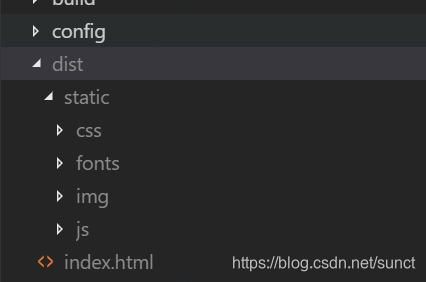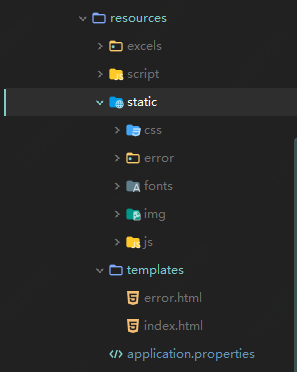最近由于工作要求:前端采用vue开发,后端采用springboot开发,前后端分离开发,最后前端页面又整合到后端来。经历多次采坑,总结以下方案:
- vue build后的文件部署到springboot目录
vue打包后,会生成dist目录

springboot静态资源目录如下:

SpringBoot处理静态资源和页面,设置如下:
@Override
public void addResourceHandlers(ResourceHandlerRegistry registry) {
registry.addResourceHandler("/static/**").addResourceLocations("classpath:/static/");
super.addResourceHandlers(registry);
}
页面模板设置,如下:
#页面模板设置
spring.thymeleaf.option=classpath:/templates/
spring.thymeleaf.suffix=.html
spring.thymeleaf.mode=HTML5
spring.thymeleaf.encoding=UTF-8
spring.thymeleaf.content-type=text/html
spring.thymeleaf.cache=false
部署方案:
dist的index.html 直接放在templates目录下
dist的css、fonts、img、js 直接放在static目录下
-
vue打包后vendor文件过大的优化方案
vue使用vue-cli打包后,vendor就将vue.js其他引用的包一起压缩打包进去,导致vendor文件超过1M,影响页面加载速度
本项目使用了vue、vue-router、iview、axios、echarts等
(1)使用vue、vue-router、iview、axios、echarts等cnd引用
在index.html文件中,增加:<script src="https://unpkg.com/[email protected]/dist/vue.min.js"></script> <script src="https://unpkg.com/[email protected]/dist/vue-router.min.js"></script> <script src="https://unpkg.com/[email protected]/dist/iview.min.js"></script> <script src="https://unpkg.com/[email protected]/dist/axios.min.js"></script> <script src="https://unpkg.com/[email protected]/dist/echarts.min.js"></script>(2)打包时,排除vue、vue-router、iview、axios、echarts等打包
在webpack.base.conf.js文件中,module.exports={…} 方法中添加module.exports = { ... externals:{ 'vue':'Vue', 'axios':'axios', 'vue-router':'VueRouter', 'iview':'iview', 'echarts':'echarts', }, ... }这里有注意的是:命名问题
比如:vue-router的在https://unpkg.com/[email protected]/dist/vue-router.min.js中默认采用VueRouter,所以在import vue-router一定要使用VueRouter,而不能使用其他别名。vue默认别名是Vue
axios默认别名是axios
vue-router默认别名是VueRouter
iview默认别名是iview
echarts默认别名是echarts例子:
import Vue from 'vue' import VueRouter from 'vue-router' import iview from 'iview' import echarts from 'echarts' Vue.use(VueRouter) export default new VueRouter({ mode: 'history', ... })(3)vue-router的路由页面设置为按需加载
export default new VueRouter({ mode: 'history', routes: [ //页面1 { path: '/Page1', name: 'page1', component: () => import('@/views/Page1.vue') }, //页面2 { path: '/Page2', name: 'page2', component: () => import('@/views/Page2.vue') } ] });(4)重新打包后vendor.js文件就小了,可以小到1k哦
-
vue-router使用了history模式,vue其实做的是单页面应用,但是效果看上去是多个不同页面,问题来了,部署到线上环境后,该如何配置?
百度上有很多处理方案,比如:使用errorPage方式处理,nginx配置等,这些问题比较繁琐,而且在部署过程中,一堆问题。
经过多次尝试,发现有一个最简单方法,Controller直接url路径配置到index.html即可,而且轻松解决history模式带来的后端问题,如下:@ApiOperation(value = "", hidden = true) @RequestMapping(path = "/Page1") public String page1() { return "index"; } @ApiOperation(value = "", hidden = true) @RequestMapping(path = "/Page2") public String page2() { return "index"; }这种方案非常有利于后端开发人员做更多的进一步操作,比如:给每个页面增加页面权限等。
注意:该方案目前适用于前端页面整合到后端的项目工程。
